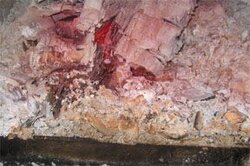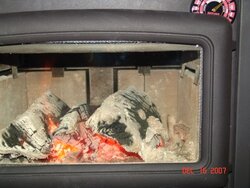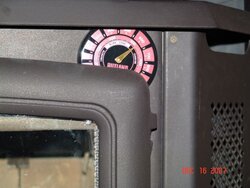I believe there is a basic flaw in the design. There only is 12" between the floor and the secondary combustion rods to work with. The bed of live coals gets several inches deep. I actually invented a scoop that sifts the ashes. Removing live coals to add more wood really defeats the purpose. To create room, ash needs to be removed several times a day. The coal bed limits the amount of wood one can load. This means maybe two logs for overnights. In the mornings I often need to let the coals cool and coast to remove ash. My experience indicates Quadrafire overestimated the stove’s output capacity by 150%.
Coals and ash plug the draft vents daily. Eventually this ash will fall into the stove somewhere and pile up. This may compromise dampers and drafts, who knows.
The firebox capacity is deceiving. I’m finding that height is a critical dimension. The stove would have been greatly improved if the floor were dropped two or three inches. The folks at Hearth and Home have not responded any of my concerns. I will consider taking a torch to it next summer. In the meantime, I purchased some additional electric baseboard. That truly does burn my butt.
I may have been spoiled by my little Earthstove. It heated my home on about two cords of wood a year. After 25 years I retired it. The damper got sloppy and it started to leak or poof too often. I once had a 36 hour burn out of it. It was rated for 1,500sq.ft. The Millennium 4300, QuadraFire's second largest stove looked like a great replacement. It's not living up to their specifications.
Coals and ash plug the draft vents daily. Eventually this ash will fall into the stove somewhere and pile up. This may compromise dampers and drafts, who knows.
The firebox capacity is deceiving. I’m finding that height is a critical dimension. The stove would have been greatly improved if the floor were dropped two or three inches. The folks at Hearth and Home have not responded any of my concerns. I will consider taking a torch to it next summer. In the meantime, I purchased some additional electric baseboard. That truly does burn my butt.
I may have been spoiled by my little Earthstove. It heated my home on about two cords of wood a year. After 25 years I retired it. The damper got sloppy and it started to leak or poof too often. I once had a 36 hour burn out of it. It was rated for 1,500sq.ft. The Millennium 4300, QuadraFire's second largest stove looked like a great replacement. It's not living up to their specifications.





